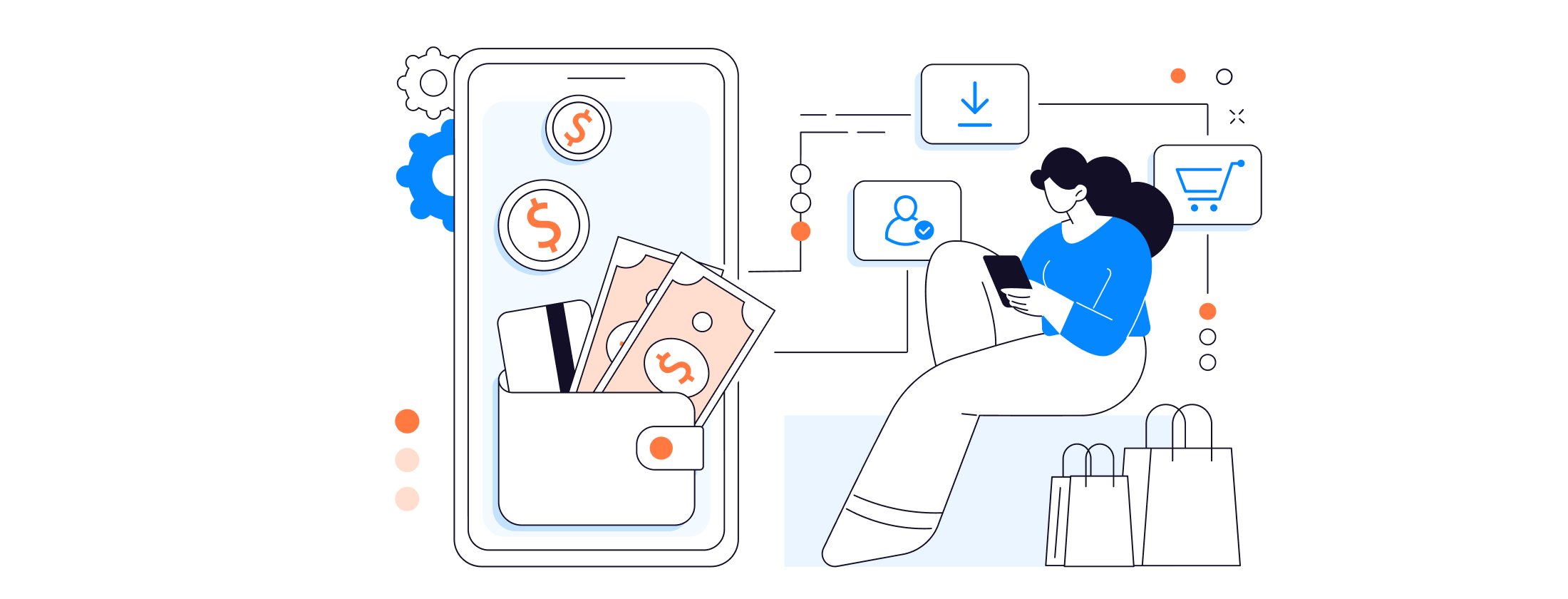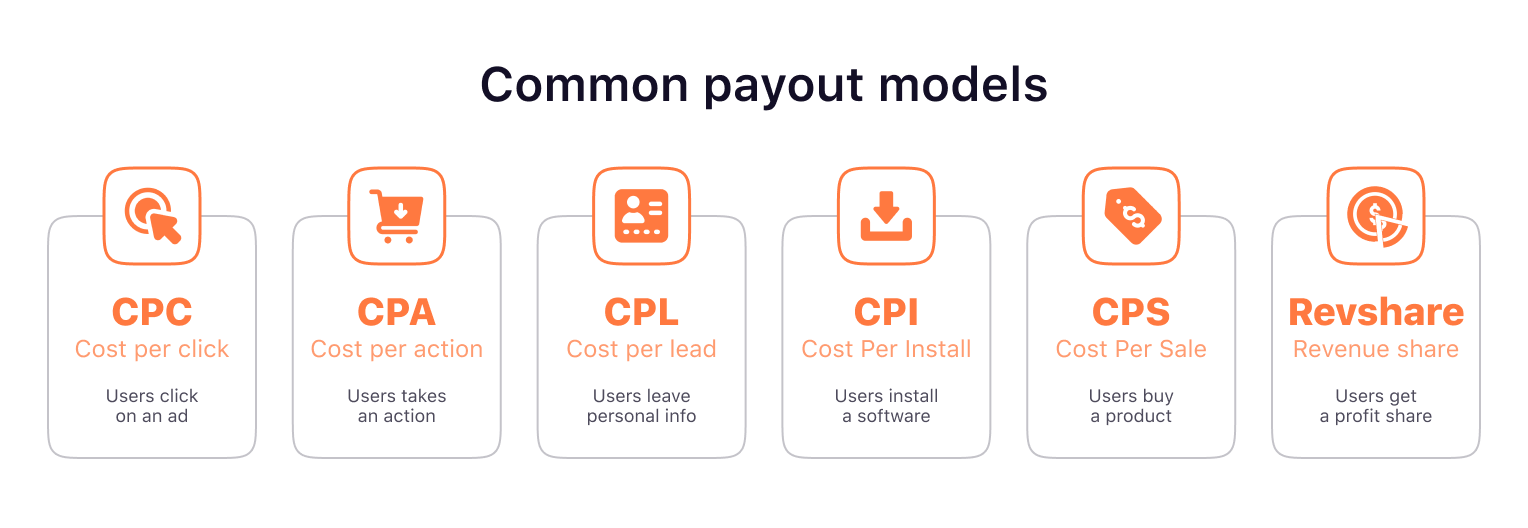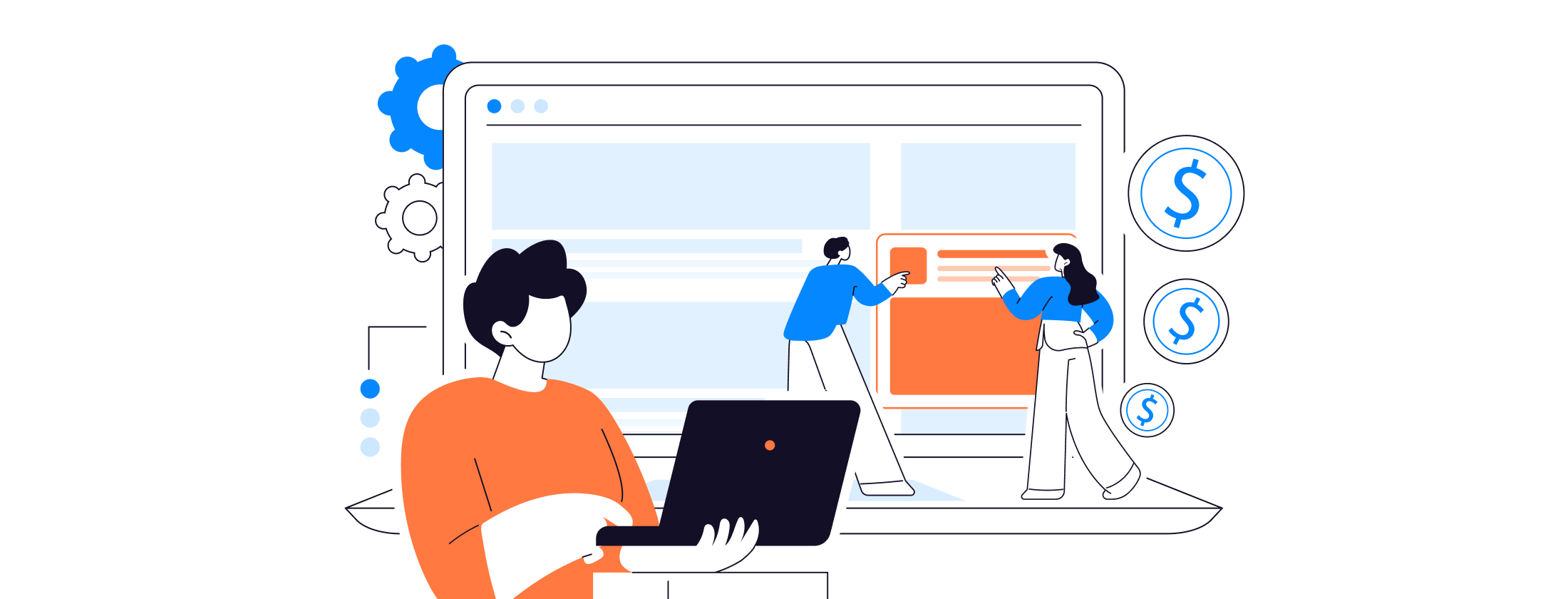Blog

Understanding payout models in affiliate marketing is essential as CPA networks offer a range of payout models – from CPC (cost-per-click) to Revshare – catering to different offer specifics and marketing objectives. The goal of this article is to delve into these widely used payout models and offer insights on how to effectively apply each one depending on the situation.
The short answer is payouts are the revenues received from conversions.
In detail, affiliates can be charged for driving sales, generated leads, and actions the user takes, such as leaving contacts or app installs. All these refer to the required conditions for paying for affiliates’ results. Roughly speaking, affiliate networks set up metrics for measuring ad performance – clicks, sales, leads, installs, revenue earned, etc. – and then pay for the conversions.
Commission structures play a crucial role in affiliate marketing, determining the financial incentives affiliates receive for promoting products or services.
Let’s get to the heart of the matter: common affiliate models in CPA networks. There are 6 types of such payout models: CPC, CPA, CPL, CPI, CPS and RevShare.

In the CPA model, affiliates are rewarded when a user not only clicks on the affiliate link but also completes a certain action. These actions can include making a purchase, signing up for a newsletter, or subscribing to a service. So, if an affiliate is promoting a software company and a user signs up for a trial, the affiliate is compensated for that action.
This model compensates affiliates for every lead generated. A lead is defined as a potential customer who shows interest in a product or service by sharing contact information.
There are 2 types of the CPL model:
This payout model applies specifically to mobile apps, where marketers are paid for each app installed by a user. It’s frequently seen in the mobile gaming industry. For instance, if an affiliate is promoting a new mobile game and a user installs this game through their referral, the affiliate earns a commission.
According to this model, affiliates earn a commission every time a user clicks on their advertising link. So, if an affiliate promotes a product through a blog and a reader clicks on the link, the affiliate receives a commission for that click. This is often used in the realms of paid search and display advertising. For example, a fashion blog affiliate might earn based on the number of clicks on the links to a new line of clothing.
CPA networks rarely operate on a CPC model, while affiliates commonly use this model to purchase traffic in advertising networks. An alternative to the CPC model in ad networks for advertisers is the CPM model. In this case, affiliates pay for impressions rather than clicks.
Learn more about the differences and advantages of these models in our article.
Upon the revenue share model in affiliate marketing, advertisers receive a portion of the income that an advertiser makes from customers referred by the affiliates. This is a popular model in online retail or gambling businesses. For example, an affiliate promoting an online casino might receive a 30% share of the revenue generated from players who deposit money via the affiliate’s referral link.
Payout amounts by different business models differ as each is on par with a certain stage of the sale funnel. Naturally, it’s much easier to encourage users to click on the ad than turn them into leads. As a result, affiliate networks pay less for CPC offers than for CPA or CPL offers when the conversion requires a specific action from the consumer.
CPS and RevenueShare are the most complex models as the conversion is considered a sale or merchants’ profit, respectively.
Choosing the right revenue model is complex and highly dependent on the specific goals of the affiliate marketer, as previously discussed.
To shelve specifics for all described models, we have complied detailed insights on each of them.
| Revenue Model | Payout condition | Difficulty level | Suitable vertical | Best use case |
|---|---|---|---|---|
| CPA (Cost Per Action) | Purchase Signup Leaving information, etc. | Depends on the chosen action | Most verticals | Advertisers have a clear understanding of their customer acquisition costs and want to pay a defined price for each action |
| Revshare (Revenue Share) | Affiliates get a portion of the revenue from sales or users’ deposits | ⭐⭐⭐⭐⭐ | Gambling Betting Finance | Affiliates can earn revenue over the lifetime of the customer referred if the product or service has high repeat purchase rates. |
| CPL (Cost Per Lead) | Signing up Leaving information | ⭐⭐⭐ | Sweepstakes Nutra Dating | The company work on a lead generation basis. If the goal of the business is to collect potential customers’ contact information for further nurturing and eventual conversion, this model works best. |
| CPI (Cost Per Install) | Installs | ⭐⭐⭐⭐ | Mobile content Extensions | The offer is a mobile app. If your business is about promoting a mobile app and increasing its user base, this model would be the best choice. |
| CPC (Cost Per Click) | Clicks | ⭐⭐ | — | This model is ideally suitable for new websites or platforms that are looking to quickly expand their reach |
The most common payment model in affiliate marketing is CPA. An affiliate can choose the action they want to be charged for or awarded for all possible results, whether sales or just leads. On the flip side, the CPC model is seducing as affiliates aren’t responsible for the user’s actions. However, such a model is tricky enough because marketers have to generate a great amount of traffic to get paid enough to live high on the hog.
To sum up, there is no one-size-fits-all revenue model in affiliate marketing. The choice largely depends on the advertiser’s specific needs, goals and the nature of their product or service.
Understanding payout models in affiliate marketing is essential as CPA networks offer a range of payout models – from CPC (cost-per-click) to Revshare – catering to different offer specifics and marketing objectives. The goal of this article is to delve into these widely used payout models and offer insights on how to effectively apply each one depending on the situation.
The short answer is payouts are the revenues received from conversions.
In detail, affiliates can be charged for driving sales, generated leads, and actions the user takes, such as leaving contacts or app installs. All these refer to the required conditions for paying for affiliates’ results. Roughly speaking, affiliate networks set up metrics for measuring ad performance – clicks, sales, leads, installs, revenue earned, etc. – and then pay for the conversions.
Commission structures play a crucial role in affiliate marketing, determining the financial incentives affiliates receive for promoting products or services.
Let’s get to the heart of the matter: common affiliate models in CPA networks. There are 6 types of such payout models: CPC, CPA, CPL, CPI, CPS and RevShare.

In the CPA model, affiliates are rewarded when a user not only clicks on the affiliate link but also completes a certain action. These actions can include making a purchase, signing up for a newsletter, or subscribing to a service. So, if an affiliate is promoting a software company and a user signs up for a trial, the affiliate is compensated for that action.
This model compensates affiliates for every lead generated. A lead is defined as a potential customer who shows interest in a product or service by sharing contact information.
There are 2 types of the CPL model:
This payout model applies specifically to mobile apps, where marketers are paid for each app installed by a user. It’s frequently seen in the mobile gaming industry. For instance, if an affiliate is promoting a new mobile game and a user installs this game through their referral, the affiliate earns a commission.
According to this model, affiliates earn a commission every time a user clicks on their advertising link. So, if an affiliate promotes a product through a blog and a reader clicks on the link, the affiliate receives a commission for that click. This is often used in the realms of paid search and display advertising. For example, a fashion blog affiliate might earn based on the number of clicks on the links to a new line of clothing.
CPA networks rarely operate on a CPC model, while affiliates commonly use this model to purchase traffic in advertising networks. An alternative to the CPC model in ad networks for advertisers is the CPM model. In this case, affiliates pay for impressions rather than clicks.
Learn more about the differences and advantages of these models in our article.
Upon the revenue share model in affiliate marketing, advertisers receive a portion of the income that an advertiser makes from customers referred by the affiliates. This is a popular model in online retail or gambling businesses. For example, an affiliate promoting an online casino might receive a 30% share of the revenue generated from players who deposit money via the affiliate’s referral link.
Payout amounts by different business models differ as each is on par with a certain stage of the sale funnel. Naturally, it’s much easier to encourage users to click on the ad than turn them into leads. As a result, affiliate networks pay less for CPC offers than for CPA or CPL offers when the conversion requires a specific action from the consumer.
CPS and RevenueShare are the most complex models as the conversion is considered a sale or merchants’ profit, respectively.
Choosing the right revenue model is complex and highly dependent on the specific goals of the affiliate marketer, as previously discussed.
To shelve specifics for all described models, we have complied detailed insights on each of them.
| Revenue Model | Payout condition | Difficulty level | Suitable vertical | Best use case |
|---|---|---|---|---|
| CPA (Cost Per Action) | Purchase Signup Leaving information, etc. | Depends on the chosen action | Most verticals | Advertisers have a clear understanding of their customer acquisition costs and want to pay a defined price for each action |
| Revshare (Revenue Share) | Affiliates get a portion of the revenue from sales or users’ deposits | ⭐⭐⭐⭐⭐ | Gambling Betting Finance | Affiliates can earn revenue over the lifetime of the customer referred if the product or service has high repeat purchase rates. |
| CPL (Cost Per Lead) | Signing up Leaving information | ⭐⭐⭐ | Sweepstakes Nutra Dating | The company work on a lead generation basis. If the goal of the business is to collect potential customers’ contact information for further nurturing and eventual conversion, this model works best. |
| CPI (Cost Per Install) | Installs | ⭐⭐⭐⭐ | Mobile content Extensions | The offer is a mobile app. If your business is about promoting a mobile app and increasing its user base, this model would be the best choice. |
| CPC (Cost Per Click) | Clicks | ⭐⭐ | — | This model is ideally suitable for new websites or platforms that are looking to quickly expand their reach |
The most common payment model in affiliate marketing is CPA. An affiliate can choose the action they want to be charged for or awarded for all possible results, whether sales or just leads. On the flip side, the CPC model is seducing as affiliates aren’t responsible for the user’s actions. However, such a model is tricky enough because marketers have to generate a great amount of traffic to get paid enough to live high on the hog.
To sum up, there is no one-size-fits-all revenue model in affiliate marketing. The choice largely depends on the advertiser’s specific needs, goals and the nature of their product or service.

Blog

Blog